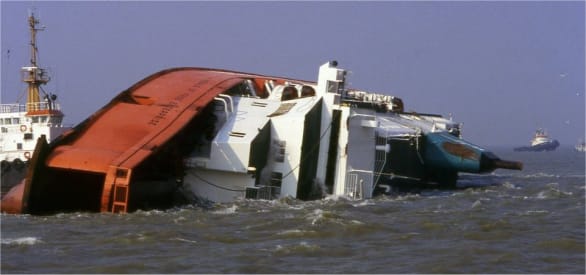The Herald of Free Enterprise, a tragic lesson in the assumption of safety
Follow articleHow do you feel about this article? Help us to provide better content for you.
Thank you! Your feedback has been received.
There was a problem submitting your feedback, please try again later.
What do you think of this article?
It was 30 years ago this year at 17.20 hours on March 6th, 1987 when the passenger and car ferry, the MS Herald of Free Enterprise passed the harbour breakwaters in the Belgium port of Zeebrugge en route to Dover. By 17.28 hours she had capsized.
The crew was embarking on the return leg of their second round trip which they complete during a 24-hour shift, so naturally many of the crew members were tired by this point. It was the job of the Bosun’s Assistant to close the bow doors, but he was asleep in his cabin and reportedly didn’t hear the harbour stations sounding, which is the alert to close the doors and for all crew members to report to their stations. The Chief Officer reportedly saw a man in orange overalls whom he assumed was the Bosun’s Assistant whilst doing his rounds and came to the conclusion that the bow doors must be shut and the Herald was ready to sail.
A recipe for disaster
As the Captain of the ship couldn’t see the bow doors from the bridge and there was no other way to substantiate if the doors were open or not, besides a visual check of the doors themselves, he relied solely upon the Chief Officer’s report that all was well. To add to the dilemma, design incompatibility of the ferry and the link-span mechanisms at Zeebrugge meant the ferry’s vehicle loading decks could not be loaded properly. The loading ramp at Zeebrugge couldn’t be raised high enough, so to compensate, the Herald of Free Enterprise was lowered in the water by 3 feet by filling its ballast tanks with water. A recipe for disaster.
As the Herald picked up speed as it left the harbour, reaching 15 knots, water began to cascade through the open doors at a rate of 200 tons per minute. As she filled up the bow dipped even further and the water ingress increased. Seven minutes later the Helmsman reported that the ship wasn’t responding, the Captain immediately put the ferry into reverse, but by then it was too late, the ship listed to port, righted itself for a moment and then capsized on her port side, landing on a sandbar. That sandbar prevented the Herald from capsizing in deep water and causing even greater loss of life, a tiny speck of luck within this tragic event that took just eight minutes to reach this point.
There were 459 passengers and 80 crew members on board that evening, along with 81 cars, 3 buses and 47 trucks. Most of the passengers were in the lounge or in their cabins. Due to the speed of the incident, there was no time for any of the passengers to take action. The panic in that ship must have been horrific as she lay on her side, with all the lights extinguished and with freezing cold sea-water cascading through the corridors.
The missing mechanisms
Both passengers and crew members and the various rescue services who reached the scene managed to save many lives, but, as a result of the serious negligence of crew members and the mechanisms employed as a ‘safety protocol’, 193 people died, mostly as a result of hypothermia. This tragic event, which I remember well, could have been avoided if safety aspects had been built into the mechanisms of the safety protocol. There are a multitude of ways this could have been prevented, from mechanical interlocks that gave a visual signal that the bow doors were shut in the control room, interlocks that prevented the engines from engaging if the doors were open, to TV cameras that show the bow door’s status and countless other methodologies. If these possible areas of failure had been captured during the design stage of the Herald of Free Enterprise and no doubt other ferries of the same class, I feel confident in saying this event would never have occurred in the manner in which it did and countless lives would have been saved.
One of the heroes of the disaster Head Waiter Michael Skippen, who tragically died saving others.
Make it safe
Building safety into a product is an essential aspect of any design and vital if you want to avoid exposure to litigation, fines, prison and all the other potential outcomes that could arise should someone be killed by a product you constructed. Designing safety into a product, understanding all the potential threat points can be a difficult task. What standards and compliance do you need to adhere to? What levels of protection are required? What are all the risks you could be exposing a user of my product to? Whatever you are building, be it a new cross-channel ferry, or a hair dryer, each and every aspect of that machine must adhere to specific standards. The more complex the design, the more complicated the process is.
If you need a solution to embed compliance into your design process then watch this space. Through DesignSpark, RS Components are about to offer a great new tool to its community.




